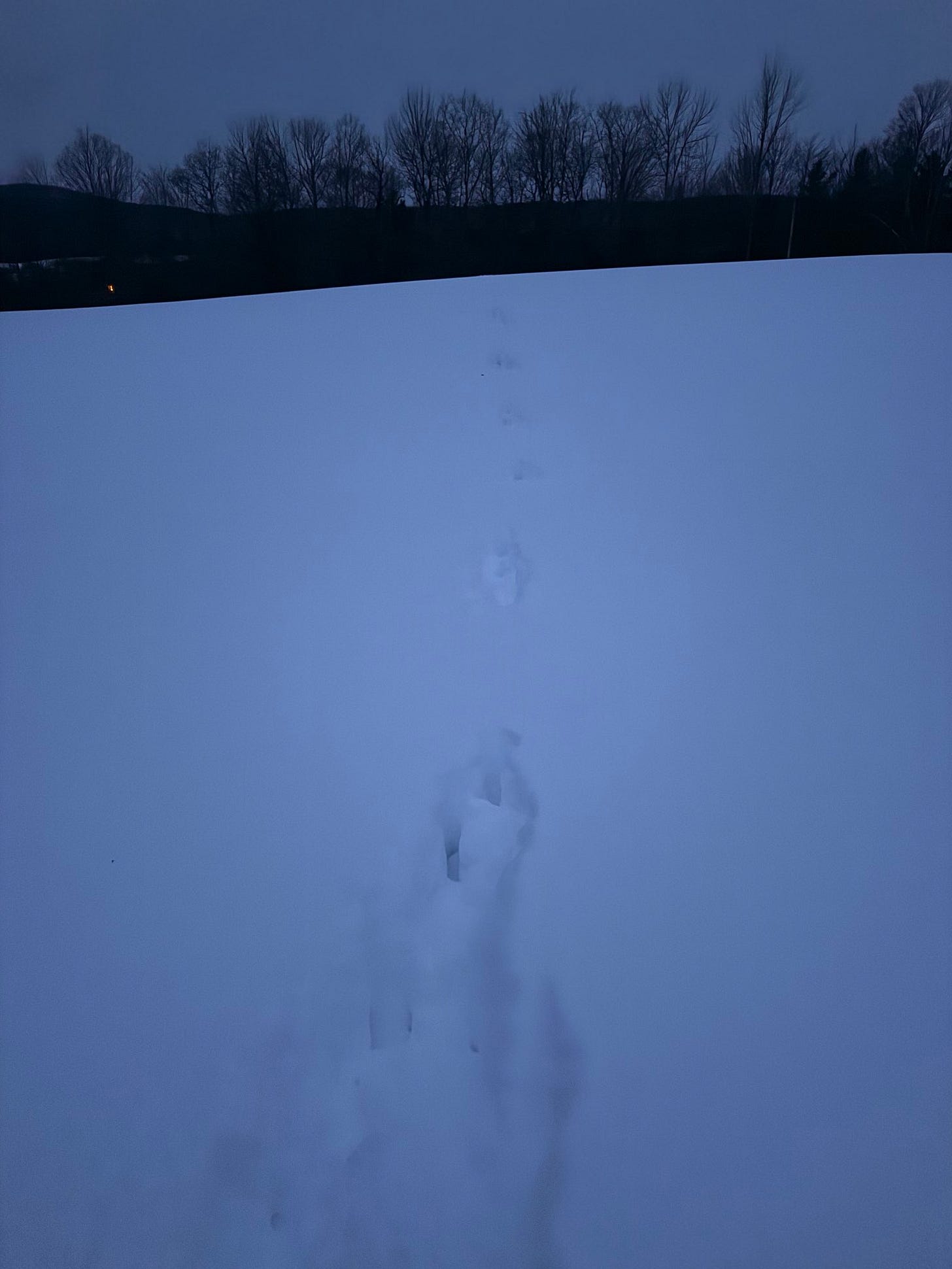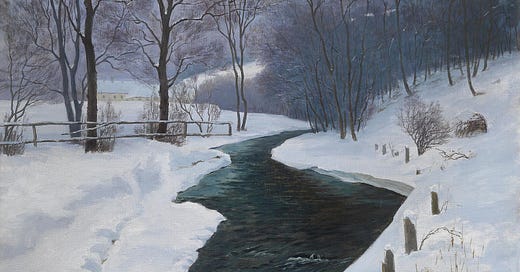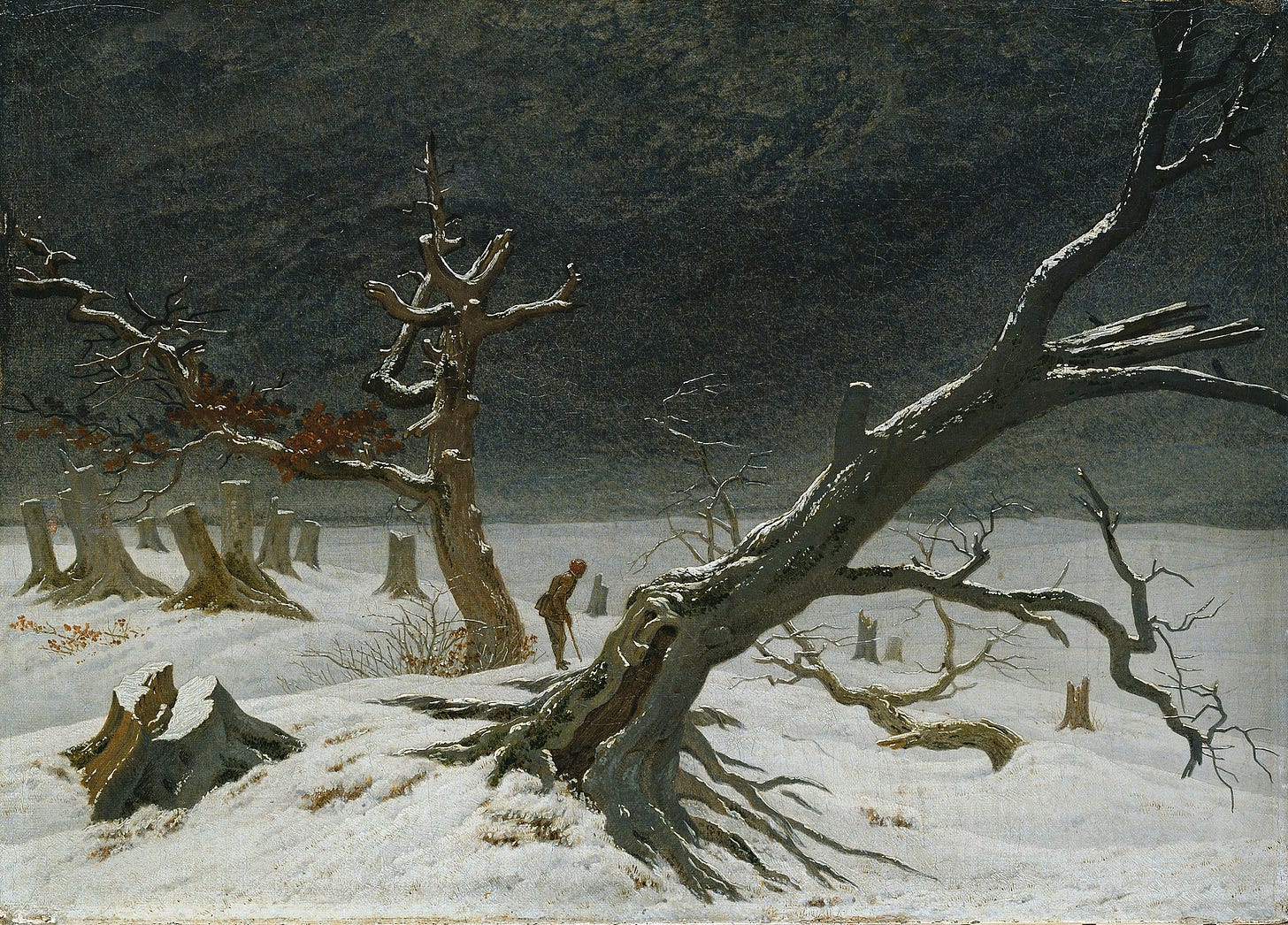The days are changing. There are more tracks in the field, the light lingers a little longer, and we never quite know what to expect from Winter here at his bitter end. Winter in February is a man who has learned that he is dying. Faced with his mortal coil, he is unpredictable, dangerous, liable to do anything. He may lash out in his rage and bury you in sleet, he may succumb to his sorrow and plunge the mercury to -20°, or he may be at peace with his fate and smile a string of warm days upon us. We do not know how Winter will react to learning of his grim fate, knowing that his days are numbered, accepting that he will die. We can look around, however, and reflect on what we want to do with our own days, what we want to bring in to the world with the time we are granted, and be inspired to act by what we see in the fields, the forests, and all the places where the good green pattern stirs beneath the snow.
Just as a man nearing his end accepts that he must put his worldly affairs in order, so too do we make the most of our good days. The coming cold weeks demand decisions and require forethought before we are made mad to act by the warm sun of March. We open our seed containers, our workshops, our barns, and look to what remains from the year prior, what can be salvaged, and what must be released. The garden must be mapped, the hives checked, the tools sharpened—not unlike a man patrolling his estate and grounds, making peace with his legacy, ensuring what he has built will endure beyond him. What must we build, what must we repair, of what must we let go? Winter's end here in February is not just about watching the thaw and hunting for snow drops; it is for preparing for the work that follows, setting things in place before the next turning of that old wheel. Seeds must be ordered, beds must be cleared, last year's missteps must be considered; all the lessons must be folded into the next cycle. We do not wait for Spring’s arrival idly now. We envision what we will do, we name it like an invocation, and we lay the foundation before the ground is warm enough to receive our efforts. Soon Winter will be gone, and we must be ready to carry on in his wake.
Sensing the imminent death of Winter, the scavengers and other predators are on the move. There is more activity in the fields now, more signs of predation. I have said before that the first true day of spring is when you first find blood on your land. Look to the woodline and you may see the large bounding tracks of a deer who broke free from the trees for the open where she could sprint away from her canine pursuers. Find the coy dogs’ grim leavings in any ravine, lowland, or ditch now. The woods hunger. The crows are bolder, the foxes more brazen. Every fang and claw inches a little closer to the farms and villages now, taking what they can before Winter breathes his last. We too begin our hunts now, but also need to face the fact that we are at risk of not being the cunning predator, but rather the bounding prey. We run from ourselves by not living up to our own potential, by making excuses, by saying “Someday.” Plans are only as strong as our execution, and this is the season for moving from thought to deed. The hive that died last year must be inspected, the fence line that sagged in places must be reset, the firewood pile that dwindled too soon must be stacked higher. We do not wait for the warmth to make us ready—we work now, molding the world in which we wish to live.

Yet even the best-laid plans must bow to reality. A late snow may crush the eager shoots of garlic, a storm may undo hours of careful labor, a hive may not survive no matter how well it was tended. We adjust. We mourn losses, reassess strategies, begin again. There is no use railing against fate, no use cursing or worrying about what we cannot control. Winter teaches us this in his final days. He fights, he rages, he weeps, but in the end, he must go. He must die. The land will wake, the world will warm, the good green pattern will emerge again. We, too, must learn when to yield, when to pivot, when to release what is beyond saving and focus on what yet remains. A diseased fruit tree becomes firewood, a failed crop enriches the soil, a dead hive donates its drawn comb to another colony. There was a farmer whose ewe birthed two lambs. One died and the ewe would not leave its side to the point of neglecting her living lamb. The farmer removed the dead lamb and the ewe would not give up; she searched for it, continuing to neglect her living lamb. The farmer then skinned the dead lamb and wrapped the living one in its hide. Only then would the mother nurse her living lamb. Though a grim tale, the farmer salvaged life where he could and, instead of two dead lambs, he ended up with one. A happy ending where there would have only been tragedy if not for his action. As you execute your own plans, you meet your failures like that farmer. You salvage, you cannibalize, you reincarnate. Then you move on.
This is the rhythm of the work, the good green pattern, the old wheel turning again. The world does not wait for mourning to end, for perfect conditions to align. The thaw will come, the fields will green, the bees will fly, and we will work with them all, knowing that even as Winter dies, we live.







This essay spurred reflection and hope.
Enjoyed this so much. Thank you.